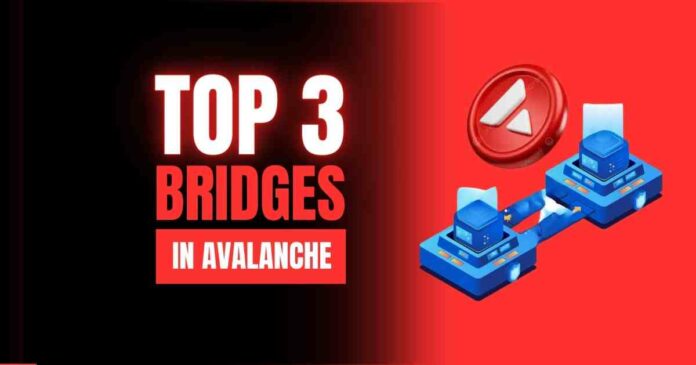Bitcoin and Ethereum have received much attention from blockchain enthusiasts. But in both networks, transactions take a long time to complete and cost a lot of money.
However, Avalanche overcomes these limitations by using a cutting-edge consensus algorithm that maintains security, decentralization, and fast transfers with low fees. Before learning the best three avalanche bridges, it is crucial to understand what Avalanche is.
What is Avalanche’s Blockchain?
Avalanche is a blockchain network that aims to address the blockchain trilemma: scalability, security, and decentralization. Avalanche’s novel consensus technique, avalanche consensus, outperforms Proof of Work (PoW) and, Proof of Stake (PoS) regarding network throughput and transaction processing speed.
With Avalanche, you can create adaptable, compatible subnets that can house a variety of resources and applications. These autonomous, independent networks can be configured to suit the requirements of specific initiatives. Consequently, there are more opportunities for network expansion and personalization.
T…S…M! T…S…M! T…S…M!@TSM #ChoseAvalanche as their exclusive blockchain partner, and will be launching a Subnet to bring @theblitzapp, the competitive gaming platform, on chain.
Buckle up, because this collaboration could revolutionize gaming.@GamingOnAvax pic.twitter.com/4NMQMhkugT
— Avalanche 🔺 (@Avax) March 7, 2023
In essence, Avalanche makes it simpler to create and execute smart contracts, which are computer-encoded contracts between a buyer and a vendor. Mediators are no longer required due to deal execution automation.
What do Bridges in Avalanche means?
In Avalanche, “bridges” refers to the infrastructure that paves the way for transferring assets and data between blockchains. If two blockchain networks need to share resources and information, a bridge can make that possible.
So, the Avalanche ecosystem relies heavily on bridges because they facilitate connectivity and contribute to a more distributed and adaptable blockchain network.
Bridges enable communication between nodes in different subnets and between Avalanche and blockchain networks. Using a bridge, users can move assets from one network to another, such as from the Avalanche network to Ethereum. Moreover, Avalanche’s innovative bridge design makes it possible to transfer assets between blockchains quickly and seamlessly.
Top 3 Bridges in Avalanche
1) Avalanche Bridge
The Intel SGX program and third-party verifiers known as “wardens” are the two main components of the AB. So, the Avalanche Foundation has given the independent wardens authority over approving money transfers over the bridge. Moreover, wardens are in charge of completing bridge requests and indexing blockchains. The bridge exclusively supports the movement of Ethereum ERC20 tokens and facilitates its transfer to Avalanche’s C-Chain.
4/ $BTC on @avalancheavax 🔺
Through the $AVAX bridge, Bitcoin can now be transported into the Avalanche Network.
This unlocks half a trillion dollars of value on the Bitcoin network for use within various DeFi applications! https://t.co/5mMmbcwGxF
— Emperor Osmo🧪 (@Flowslikeosmo) March 16, 2023
The native token of the Avalanche network, AVAX, must be used to pay transaction costs on the web. For Ethereum transactions, bridge transfers typically take 10-15 minutes, while Avalanche transactions only take a few seconds.
Besides, accessing the Avalanche Bridge only through the authorized UI and adhering to the provided tutorials is crucial if you want to use it successfully. Ava Labs cannot recover lost funds due to user error, and improper utilization can result in permanent loss of funds.
2) Multichain Bridge
Formerly known as Fantom Anyswap, Multichain Bridge is a cross-chain system that allows for the exchange of assets between different blockchains. It utilizes Multi-Party Computation (MPC) to encrypt asset transfers between chains and streamline interchain transactions.
Source: Homepage
Multichain Bridge provides a secure and efficient way for transferring assets between different blockchain networks, unlocking new possibilities for cross-chain interoperability in the decentralized finance (DeFi) space. It offers:
- Asset Locking: A smart contract on the source network locks the asset when transferring it to another blockchain. The MPC network secures this smart contract, which comprises nodes operated by various organizations, institutions, and individuals.
- Asset Wrapping: Users can trade this wrapped asset on the target network instead of the original one.
- Redeeming: The smart contract on the source chain releases the original asset when the users no longer need the wrapped asset on the destination chain and burns it.
- Custodial Bridges: Chain liquidity is not necessary for custodial connections from Multichain. When projects introduce ERC-20 tokens on new networks devoid of tokens, they are most helpful.
- Bridged Assets Smart Contract: The Multichain Router V3 prototype mainnet includes a function that enables the creation of assets on the chain by Multichain. Users would find this option sensible, primarily if they built the product on Ethereum.
Currently, Multichain supports more token types than any other cross-chain bridge service available. You can view more details of the project from its official website.
3) Synapse
The Synapse Bridge is a component of the Synapse Protocol, a dominant cross-chain DeFi network. Synapse Bridge’s mission is to facilitate the exchange of value between different blockchains like Ethereum and Binance Smart Chain.
Source: Homepage
Furthermore, users can now transfer assets between blockchains using the Synapse Bridge, eliminating the need for costly, time-consuming, and possibly risky centralized exchanges. Through its universal interoperability model, the Synapse Bridge allows users access to liquidity and other DeFi services across multiple blockchains.
How Synapse Bridge Work?
As soon as a user locks down an asset on one blockchain, Synapse Bridge generates a fake one on the other chain with the same value for the user to access DeFi services. The synthetic asset can be unlocked by the user at any time, destroying the asset and releasing the original tokens back to the user.
Moreover, the development of secure cross-chain applications demands higher security standards than single-chain ones. The bridging trilemma arising from the flexible networking infrastructure of cross-chain systems complicates security requirements. Synapse addresses these challenges by prioritizing security above everything.
On a side note, Synapse Bridge thwarted a multi-million exploit in November 2021, preventing a hacker from draining approximately $8 million from the Avalanche Neutral Dollar (nUSD) Metapool.
Which Bridge for Avalanche is Better?
Despite the recent high-profile breaches in cross-chain protocols, cross-chain bridges represent the future wave of innovation. So, choosing the appropriate cross-chain bridge depends on the user’s specific requirements and objectives. The three different bridges that we covered in this article have their pros and cons. To recap:
- Synapse bridge provides multi-directional cross-chain transactions without interruptions, enabling users to transmit assets between Avalanche and other blockchains.
- Multichain Bridge (MB) is ideal for projects requiring ERC-20-like token interoperability and general use. It leverages Multi-Party Computation (MPC) to speed up transactions between chains and offer the highest levels of usability and user-friendliness.
- The Avalanche Bridge (AB) offers the highest level of trust and security, using Intel SGX and third-party verifiers called “wardens,” but is limited to Ethereum and Avalanche.
It is crucial to comprehensively analyze the traits and risks connected with each choice before deciding to use one of the bridges.
⬆️ For more cryptocurrency news, check out the Altcoin Buzz YouTube channel.
⬆️ Our popular Altcoin Buzz Access group generates tons of alpha for our subscribers. And for a limited time, it’s Free. Click the link and join the conversation today.




























